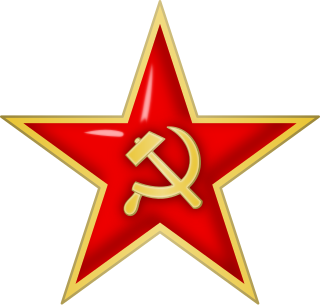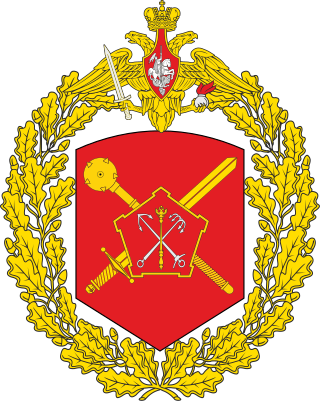History
The Army was formed in September 1939, in the Moscow Military District, and then deployed to the Western Special Military District. During the Soviet invasion of Poland it consisted, according to Steven Zaloga, of the 11th Rifle Corps (6th, 33rd, and 121st RD); the 16th Rifle Corps (8th, 52nd, and 55th Rifle Divisions); and the 3rd Rifle Corps (in reserve) (33 and 113 RDs), under General Ivan Zakharkin. [1]
On 22 June 1941, at the onset of Operation Barbarossa, the Army was part of the Soviet Western Front. It consisted of the 1st Rifle Corps (2nd and 8th Rifle Divisions); 5th Rifle Corps (including 13th, 86th, and 113th Rifle Divisions); 6th Cavalry Corps (6th and 36th Cavalry Divisions) and 6th and 13th Mechanised Corps, [2] under General K.D. Golubev. It was encircled by German forces in June 1941 and largely destroyed.
By late June, the German Army Group Centre surrounded the 3rd, 4th and the 10th Armies in the Battle of Białystok–Minsk. In the end, all the formations and units of the 10th Army were defeated. On 30 June, while trying to cross the highway Minsk-Baranovichi, the army headquarters was destroyed, coming out of the remnants of the environment were addressed by fitting of the 4th Army. The headquarters was officially disbanded on 5 July 1941. The commander of the 10th Army, Major General KD Golubev, and the army artillery commander, Major General M. Barsukov, escaping from the encirclement in a consolidated group with the August 86th Border Detachment of the NKVD, in late July Golubev was appointed commander of 13th Army, which participated in the Battle of Smolensk.
It was formed three times in 1941, next in October in the Southern Front, but its formation 'was halted due to severe battle conditions'. [3]
It was then reformed in November 1941 in the Volga region, with nine divisions, seven of which were new formations. Soviet official websites give the nine divisions as the 322nd, 323rd, 324th, 325th, 326th, 328th and 330th Rifle, and 57th & 75th Cavalry, thus including two cavalry divisions. Nine of these divisions had been formed in the space of three weeks from the reserve of the Moscow Military District and been trained for 12 hours a day. General Lieutenant Filipp Golikov took command. Golikov's 1967 book describes how the army finished its concentration in the Penza area on 8 November 1941, after which 15 days were devoted to combat training and 5 days to construction of living quarters and other facilities. [4] There were shortages of everything including warm winter clothing. The majority of the troops were between 30 and 40 years of age and, in some cases, up to 65% of the men had no military training. Initially part of the Reserve of the Supreme High Command ( Stavka Reserve), it was reassigned to the Western Front for the Battle of Moscow, after moving up to Ryazan attacking on the morning of 6 December 1941. In 1942, it continued its defensive operations on the central axis, and in 1943 took part in the second Battle of Smolensk.
The 10th Army headquarters with associated units was withdrawn from the Western Front to the Stavka Reserve in early April (General Staff's directive of 7.04.44). From 10 April, it was moved to Roslavl, where it was to take control of the 81st and 103rd Rifle Corps (total 5 divisions). That same month, the army was disbanded and its headquarters formed the basis of Headquarters 2nd Belorussian Front while its formations were reassigned to the 49th Army.

The Western Front was a front of the Red Army, one of the Red Army Fronts during World War II.

The 1st Guards Army was a Soviet Guards field army that fought on the Eastern Front during World War II.
The 3rd Army was a field army of the Red Army during World War II.
The 4th Army was a Soviet field army of World War II that served on the Eastern front of World War II and in the Caucasus during the Cold War. It was disbanded after the fall of the Soviet Union, with its divisions being withdrawn to Russia and disbanded.
The 110th Rifle Division was a formation of the Soviet Union's Red Army during the course of World War II, which was formed, dissolved, and re-formed three times throughout the war.
The Bryansk Front was a major formation of the Red Army during the Second World War.
The 12th Army was a field army of the Red Army formed multiple times during the Russian Civil War and World War II.

The 6th Army is a field army of the Red Army and the Soviet Army that was active with the Russian Ground Forces until 1998, and has been active since 2010 as the 6th Combined Arms Army.
A rifle corps was a Soviet corps-level military formation during the mid-twentieth century. Rifle corps were made up of a varying number of rifle divisions, although the allocation of three rifle divisions to a rifle corps was common during the latter part of World War II.
The 9th Army of the Soviet Union's Red Army was a Soviet field army, active from 1939 to 1943.
The 19th Army was a field army of the Soviet Union's Red Army, formed in 1941 and active during the Second World War. The army was formed three times, although only two of its formations saw combat.
The 8th Rifle Division was a military formation of the Soviet Union's Red Army in the Winter War, the Soviet invasion of Poland, and World War II. It was formed three times.
The 27th Army was a field army of the Soviet Union's Red Army, which fought in World War II.

The 20th Army was a field army of the Red Army that fought on the Eastern Front during World War II.
The 52nd Army was a field army of the Red Army of the Soviet Union in World War II, formed twice.
The 25th Army was a Red Army field army of World War II that served in the Russian Far East.
The 316th Rifle Division was formed as a Red Army division during World War II. The division was initially formed in July 1941, renamed the 8th Guards Rifle Division on 18 November 1941. The division was recreated at Vjasniki in July 1942, fought in the early battles around Stalingrad and was disbanded in November 1942. The division was recreated for the third time from the 57th and 131st Rifle Brigades in September 1943. The division ended the war assigned to the 27th Army of the 3rd Ukrainian Front.
The 32nd Army was a formation of the Soviet Army during World War II. The army was formed twice during the war, disbanded as part of the post-war demobilization and then reformed in 1969 to protect the Soviet-Chinese border.
The 43rd Army was a Red Army field army of World War II that served on the Eastern Front. Formed in late July 1941, the army fought in the Battle of Smolensk (1941). It was forced to retreat after German troops broke through in October 1941 and subsequently fought in the Battle of Moscow. The army then fought in the Rzhev-Vyazma Offensive. After the end of the offensive, the army held its positions and transferred to the Demidov area in late 1942. It fought in the Battle of Smolensk (1943). During the summer of 1944 the army fought in Operation Bagration. In the fall the army advanced into the Baltic region and fought in the Riga Offensive (1944) and the Battle of Memel. In 1945 the army fought in the East Prussian Offensive before being placed in reserve near the end of April. The 43rd Army was disbanded postwar in July 1946.
The 325th Rifle Division was formed in September 1941, as a standard Red Army rifle division, made up of older reservists and young men with no prewar training. As with many other divisions in the 320–330 series it was flung into the fighting west of Moscow in the 10th Army to defend the capital and then to take part in the winter counteroffensive. After a year on a quiet sector the division rejoined the fighting in the late winter of 1943, eventually distinguishing itself sufficiently to be redesignated as the 90th Guards Rifle Division. After disappearing from the Soviet order of battle for more than a year a new division was formed in the spring of 1944, based on a cadre of two distinguished rifle brigades, and gave very creditable service for the duration, completing its combat path in East Prussia.
This page is based on this
Wikipedia article Text is available under the
CC BY-SA 4.0 license; additional terms may apply.
Images, videos and audio are available under their respective licenses.




